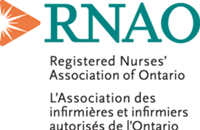RNAO says Auditor General's report points to need for overhaul of Community Care Access Centres
TORONTO, Sept 23, 2015 /CNW/ - The top professional nursing organization in Ontario, which has been a vocal critic of the province's Community Care Access Centres (CCAC), says it welcomes the findings of Auditor General Bonnie Lysyk's report, and urges the health minister to act fast.
"The long-awaited report paints a vivid picture of what's wrong with the way home and community care has been delivered in Ontario and its failure to adequately meet the needs of the people it's supposed to help," says Vanessa Burkoski, president of the Registered Nurses' Association of Ontario (RNAO). "The auditor general raises important facts about what portion of funding is going directly to patient care, inconsistencies in how care is being delivered ‒ not only from region to region ‒ but also within the same CCAC, and the compensation executives who are in charge of the province's 14 CCACs receive."
RNAO says language within the report itself makes it clear the status quo can't continue and that full scale change is necessary. The auditor notes: "… this is an optimal time for the government to further undertake a high-level, comprehensive analysis of what kind of a home-and community-based health-care delivery model would provide the highest quality of care most cost-effectively. The solution is not simply to add initiatives and make adjustments to existing services, leaving core problems and inconsistencies entrenched."
"The bottom line is that the operational structure of CCACs is not working. We know this, people who rely on home care services know this and the government knows this. Now we need to fix the system so that people aren't shortchanged when it comes to getting the care they need to remain healthy and safe in their homes," says Burkoski.
Among the findings in Lysyk's report is that while CCACs claimed that 92 per cent of their expenditures go to direct patient care, only 61 per cent was spent for actual face-to-face treatment to patients.
RNAO believes better use of taxpayers' dollars can be achieved by transitioning the CCAC's functions and funding to other parts of the system. This includes taking the $2.4 billion allocated to CCACs and expanding the mandate of LHINs to include whole system planning, funding allocation, and monitoring the value for money Ontarians are getting.
In fact, this was one of the key recommendations RNAO made in 2012 when it launched its own report into how CCACs operate and called for a complete revamping of community services to improve timely access and service quality for Ontarians. The Enhancing Community Care for Ontarians (ECCO) model, the association envisions, would use existing funding and redirect it to strengthen the system. In addition to a greater role and accountability assigned to LHINs, the ECCO model proposes to transition the 3,500 care coordinators who currently work in CCACs to primary care where they would serve as a key point of contact for people navigating the health system. "By anchoring our health system in primary care, you create a seamless system so that when someone is discharged from hospital, they are guaranteed to get the follow up they need from a health professional who is already familiar with them and can trigger the support and care they need at home," says Doris Grinspun, RNAO's Chief Executive Officer. Grinspun adds that care co-ordinators working within Community Health Centres, Nurse Practitioner-led clinics, Family Health Team, Aborignal Health Access Centre and other primary care settings are "ideally suited to provide care-coordination and system navigation to help ensure no one falls through the cracks."
When it comes to the provision of home care services, RNAO says home care agencies should rely on clinical evidence and the needs of clients to determine how many hours of care people require. "Removing the current red tape that unfortunately exists between CCACs and home care agencies is vital to making our health system more person-centred, more responsive, and more cost-effective," says Grinspun.
RNAO is urging Minister Hoskins to stop fixing the unfixable and focus on real restructuring. "We call on the Minister to set up a task force and get on with the real work ahead. A task force that reports back within six months and that produces targets and timelines for transitioning the CCAC's functions and funding to other parts of the system is what we need," says Grinspun.
"We have enough reports. If the government is serious about putting patients first, we need real change in our health system, not more money and effort on a broken model," added Grinspun.
This year marks the Registered Nurses' Association of Ontario's (RNAO) 90th anniversary. RNAO is the professional association representing registered nurses, nurse practitioners, and nursing students in Ontario. Since 1925, RNAO has advocated for healthy public policy, promoted excellence in nursing practice, increased nurses' contribution to shaping the health-care system, and influenced decisions that affect nurses and the public they serve. For more information about RNAO, visit RNAO.ca or follow us on Facebook and Twitter.
SOURCE Registered Nurses' Association of Ontario

or to arrange an interview with a nurse, please contact: Marion Zych, Director of Communications, Registered Nurses' Association of Ontario (RNAO), 416-408-5605 (office), 647-406-5605 (cellular), [email protected]

Share this article